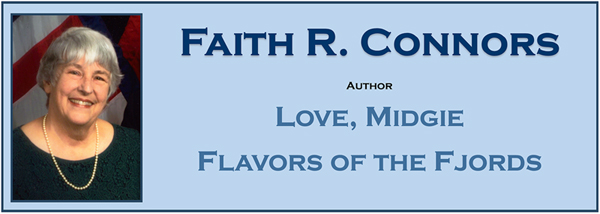A bygone gem and our vintage house of the day is a 1905 Queen Anne Shingle Style that was designed and built by William Mead Raymond for his wife, Lucy Wilden Selleck.

The house that once stood at 751 Main Street in Stamford, Connecticut, was home to a small family of three: Will, Lucy and Bill, Jr. On moving day, Bill, Jr., an infant, was carried into the house on a pillow.
At the rear of the property was a barn for the horse, however transportation to downtown Stamford was convenient enough and owning a family horse was not critical: the trolley went past the front of the house.
The barn appears to have living quarters on the second story. This is where the hired man, nameless for now, stayed.
In later years, we had the hired man’s bed, as it was called, at our house on Clark’s Hill. An iron bedstead, painted dark green, with flat springs strung from head to foot, the bed was bouncy enough to jump up and down on, a virtual rectangular trampoline in the back bedroom.

Our two and a half-story, 19th Century Shingle Style house, is a spirited in-town house with a wrap – around front porch and a second floor balcony. The front porch and second story bedroom windows, on the front and on the west side, are shaded by striped awnings. A few Victorian elements are to be noted on our shingle clad house with wood porch columns: the middle window, of the three decorative attic windows, is arched. It is interesting to note the Victorian touches because Shingle Style is also Victorian, late Victorian 1890-1900.
The overall design of our ancestral home at 751 Main Street in Stamford is related to the Queen Anne style. Our house offers up one Victorian hallmark: we note a decorative half-round window in the center of the second story. Our house has a gambrel roof.
The house that Will built for Lucy was fashionable for its time. All I have left of this heirloom house, long since torn down, is several photographs, professionally taken. No doubt, houses similar to the one at 751 Main Street had been seen by Will on his visits to Shippan Point.
Many houses of this type were built by the water, where Lucy might have preferred to live, however Will opted for in town convenience. Instead of building the family’s second home, (their first house having been built by Will on Hope Street), on the shores of Long Island Sound, he built the house for Lucy in town.
Scrolling the internet, it is sometimes possible to find similar houses, however there are very few of the pretty Queen Anne houses left. OldHouseJournal.com is a site worth visiting. HistoricProperties.com is another site I visited. “This Old House” magazine may be available from the library.
Perhaps because of the trolley making its way past the house day after day, the view from 751 Main Street may have become too busy for the Raymond family. Then, too, Will was troubled by how often the family horse died and had to be replaced. It saddened Will to see his horse sicken and die, one after another. The hired man had no luck in keeping Will’s horse alive.
In hopes of saving the newest horse, Will read a book entitled, “Practical Home Veterinarian” by Dr. David Roberts. The doctor also peddled Physic Balls, two pills for fifty cents. Perhaps the little brown box of pills, with a picture of Dr. Roberts on the top, would save Will’s horse now comfortably settled in the barn.
The hapless hired man, nameless for now, couldn’t seem to keep a horse or himself out of harm’s way. Soon after Lucy and Bill, Jr. had gone for a walk, the hired man followed the same path. When Lucy saw a wire across the path in front of them, possibly a fallen trolley wire, she told her small son, “Step over that wire, Billy.” Lucy and Billy stepped over the wire and went on their way.
Minutes later, the hired man stepped on the wire and was electrocuted on the spot. The nameless-for-now hired man may have gotten his name in the Stamford Advocate since accidents and mishaps involving trolleys often made the press.
Will soon interviewed a new candidate for the position of hired man. When John arrived for the interview, he asked, “How long will this job last?” John wanted job security.
Will said, “Come with me.”
Will and John went to the barn.
Will said, “You see this horse? As long as this horse is alive, you have got a job.”
The horse lived for many years and John worked for the Raymond family for many decades, long after the horse’s demise.

After living in the Queen Anne house for several years, Will devised a two-part plan. Lucy would have her shingle style house at the beach on Shippan Point and a cottage in the country as well. The cottage in the country was built on Newfield Avenue, not far from the farm Will’s family had worked in the late 1880s.
Will’s cottage in the country, also shingle style, was vastly larger than the house on Main Street: it was a house of twenty-two rooms, including a billiard parlor. There is a professional photograph of this house as well as a series of interior photographs of the beach house on Shippan Point.
751 Main Street was first sold to Joe Horne, Vice president of Yale & Towne. In later years, the house became the home of the American Legion. The Truman McHatten family of eight lived on the top floor while Mr. McHatten served as the manager/permittee of the American Legion.
© Copyright 2015 Faith R. Connors
